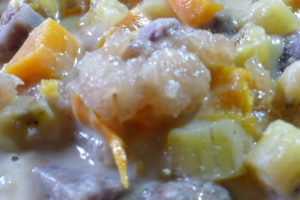
WHO can tell me where the word “Binignit” comes from? It is that sweet and creamy concoction we love to eat for “painit” (warm snack) on a cold rainy day or even on a sweltering afternoon. This is the stew-like blend of sliced cardaba bananas, squared ube and gabi, sliced nangka, diced camote and landang all floating in a thick soup of coconut milk.
The Tagalogs call it Guinataan. The word “ginataan” means that the preparation has coconut milk (gatâ) added to it. So why do Cebuanos call this delicious snack “binignit”?
It might have something to do with “init” or the word that means “hot.” Indeed, Binignit
is piping hot when removed from the fire. When it is ladled into your bowl and you excitedly scoop and bring the spoon up to your mouth scoop… Init!
Certainly, Binignit does not refer to any of its ingredients. But one thing for sure: Instead of bilo-bilo (rice flour balls), which people in Luzon prefer to add, our Binignit has landang or processed tapioca product made from a native palm (Buli or Buri Tree) flour.
I hope somebody picks up this question. We cannot remain in a fog over a word which is the name of a favorite painit of Cebuanos! And while I’m at it, there are other dishes with names I have yet to fully grasp, like biko, bukhayo, and bibingka. Surely, someone out there must have the answers.
Binignit
1 medium gabi root , cubed
2 camote or sweet potatoes, cubed
1 small ube, cubed
4 ripe saba bananas, cubed
4 segments nangka, cut up
1/2 tsp salt
3 cups brown sugar
1 cup Landang, soaked
8 cups thin coconut milk
2 cups thick coconut milk
To extract coconut milk:
The ratio is 1 cup water for 1 grated coconut.
Place the 2 grated coconuts in a big bowl.
Add 2 cups water and massage the grated coconut with it.
Place in a colander squeeze the liquid into a bowl.
Set aside.
Place the grated coconut back into the big bowl. Add 8 cups water and work into the coconut.
Place in a colander and squeeze the liquid into a big bowl.
This is the second extraction.
Boil 8 cups thin coconut milk in a big pot or kettle. Add gabi and boil for 5 minutes then add the ube, camote, bananas and landang. Cook for 15 minutes. Add the nangka, salt, and brown sugar. Continue cooking for 10 minutes more then pour in the 2 cups thick coconut milk. Bring to a boil then immediately
remove from the fire.